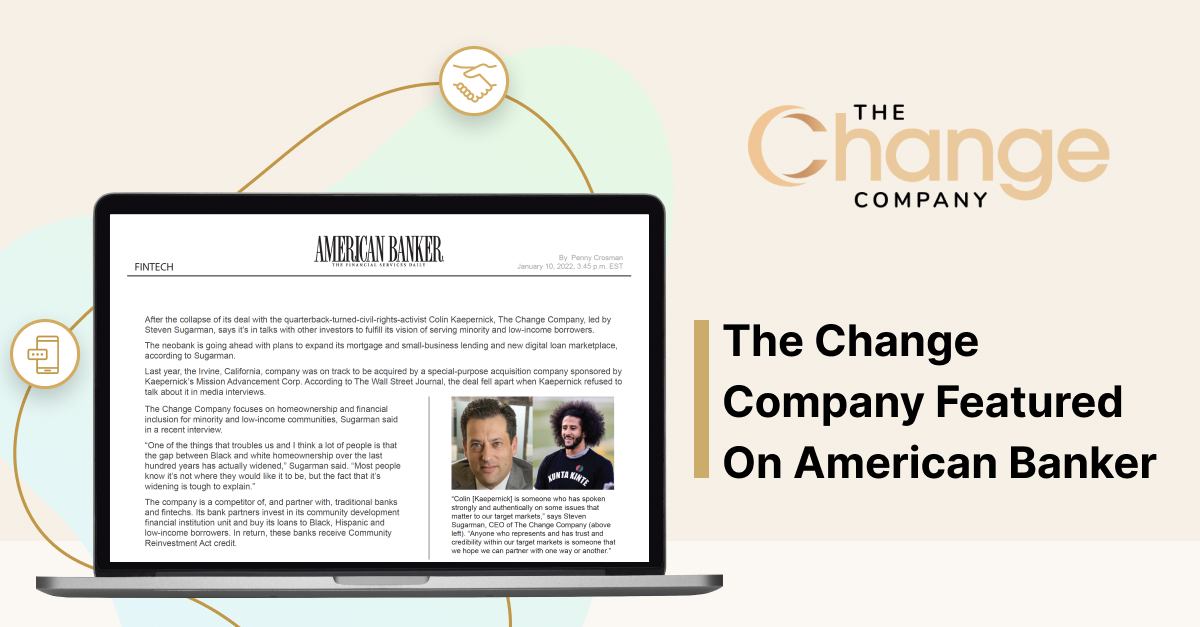Comments to Proposed CDFI Fund Rule
Tonya McInnis
Program Manager
Office of Certification, Compliance Monitoring and Evaluation
Community Development Financial Institutions Fund
U.S. Department of the Treasury
1500 Pennsylvania Ave. NW
Washington, DC 20220
Re: Request for Public Comment – Community Development Financial Institutions Program Certifications Applications, Federal Register Document No: 2022-24082
Dear Ms. McInnis:
Introduction
The Change Company (“Change”) and its Community Advisory Board submits this comment with respect to the Community Development Financial Institutions Fund’s (the “Fund”) proposed changes to Community Development Financial Institution (“CDFI”) certification, information collection, and compliance.
Change was formed in 1994 and received certification as a CDFI in 2018. Change primarily focuses on serving the underserved and underbanked by providing access to prime home and small business loans to Black/African American, Hispanic/Latino, and low- to moderate-income(“LMI”) borrowers and communities so that they may take part in the American Dream of homeownership. Change is licensed to lend in 47 States and the District of Columbia, an approved seller/servicer for Fannie Mae, Freddie Mac, Fair Housing Administration, VA, USDA, and Ginnie Mae. In 2021, Change originated approximately $8 billion in residential home loans and Change believes it is the largest CDFI residential home lender by dollar volume in America.
Change shares the Fund’s belief that “[t]o meet the CDFI Certification requirements for responsible financing practices, an entity should provide Financial Products and Financial Services in a way that does not harm consumers.” Unfortunately, certain aspects of the Fund’s proposal (the “Proposal” or the “Fund’s Proposal”) would cause the Fund and/or CDFIs to violate fair lending and consumer compliance laws and harm minority and low-income consumers. These proposals are inconsistent with existing Consumer Financial Protection Bureau (“CFPB”) and state regulations applicable to CDFIs and, contrary to the mission of the CDFI Fund, would reduce access to credit for underserved populations such as LMI and minority borrowers.
The CDFI Fund’s proposals pose several problems:
- The Proposal mandates that CDFIs not offer a CDFI’s Minority and LMI borrowers certain products, even if the products are consistent with the CFPB’s consumer regulations, would be in the borrower’s best interest, and are requested by the CDFI’s Board as part of the Board’s mandate to hold the CDFI accountable to its Target Markets.
EXAMPLE: The Change Company serves numerous Latino/Hispanic borrowers who have owned their homes for 15 years or more and paid their existing mortgage each month as agreed. In one recuring scenario that is representative of many similar situations encountered by Change, these borrowers have paid down their remaining mortgage amounts to represent less than 20% loan-to-value on their respective homes. The borrowers then seek cash-out refinances (often at lower rates than their existing mortgage) to cover an unforeseen expense, such as medical bills or procedures, issues related to their automobiles, which are necessities for job functions, or for various other emergency needs.
These borrowers’ incomes have all increased over the 15 plus years and will likely continue to increase, they have prime FICO scores often over 720, and their outstanding balances of their new loans will result in no more than a 50% loan-to-value ratio. These borrowers also desire to obtain a payment identical to what it has been, and that they have afforded for the last 15 plus years. The borrowers and their originators believed a loan with a 5-year interest only option was in the borrower’s best interest. The CDFI qualified the borrowers for this loan using full income documentation based on the CFPB’s Ability-to-Repay Rule (“ATR”)1.
This prudent, fair, and responsible approach prevents borrowers from having to rely on predatory loans (such as loans from payday lenders), allows the borrower the comfort of a minimal payment during a brief turbulent time and each of these borrowers are required to attend HUD approved counseling prior to closing the loan to ensure they make an informed decision that is best for them. Furthermore, the CDFI’s Board, as part of its mandate to hold the CDFI accountable to its Target Markets, also must agree that this solution is the best approach under these circumstances given the lack of other similar, responsible options in the marketplace.
Under the Fund’s Proposal, applicants for CDFI certification would be disqualified from becoming certified, or maintaining their certification, if they make such a loan. Based on a CDFI’s additional layer of governance, its regulatorily proscribed mission of promoting community development, additional safeguards such as providing financial literacy courses and history of service to minority communities, the Fund should have a strong desire for such CDFIs with these controls to serve such borrowers. However, the unintended consequence of the Fund’s Proposal would be to steer minority borrowers away from CDFIs to Non-CDFIs that retain the ability to make interest-only loans under the CFPB’s ATR Rule, or even worse, cause minority borrowers to not obtain financing at all or obtain high-cost financing with payday and other, which provide loans on less favorable terms.
- The Proposal would create fair lending concerns by requiring more minority consumers to accept loans with much higher monthly payments than would otherwise be necessary.
EXAMPLE: As provided in the example above, even borrowers with the most pristine credit characteristics, lowest debt-to-income ratios, and substantial equity in their property often find safety and security in having the lowest “required” payment possible while having the option to pay additional principal at their discretion. The Fund’s Proposal seeks to abolish this industry accepted practice altogether for CDFIs. Considering CDFIs, as required by regulation provide a majority of their loans to Target Markets mainly consisting of minorityborrowers2, this practice would create a disparate impact on minority borrowers.
The default discrimination provisions of Regulation B state that “a creditor shall not discriminate against an applicant on a prohibited basis regarding any aspect of a credittransaction3. “Prohibited basis,” relevant for these purposes, “means race, color, religion, national origin, sex, marital status, or age (provided that the applicant has the capacity to enter into a binding contract)4.” The Official Interpretation to the general rule provides “whether or not specifically prohibited elsewhere in the regulation, a credit practice that treats applicants differently on a prohibited basis violates the law because it violates the general rule. Disparate treatment on a prohibited basis is illegal whether or not it results from a conscious intent to discriminate5.”
Even if done with the best of intentions, depriving some minority borrowers and not other minority borrowers, or depriving minority borrowers of options permitted to similarly situated white borrowers, is unlawful. The Fund’s Proposal to prohibit a certified CDFI (that makes a majority of its loans to minority borrowers) from allowing minority borrowers access to reduced payments through extended terms and interest-only payments, stares directly opposite the black letter of Regulation B, the spirit contained in the Equal Credit Opportunity Act and the Fair Housing Act, and traditional notions of equality and fairness.
We believe that any loan product that bank regulators and the CFPB find to be safe and sound and consistent with consumer protections, should be available for consideration for Black and Hispanic borrowers to the same extent they are available to white borrowers.
- The Prohibition in the Fund’s Proposal against interest-only features is arbitrary and capricious.
The CFPB has found that interest-only loans can be called “Super Prime” should they be made prudently where the borrower has a low loan-to-value ratio and other prime credit attributes. The CFPB has distinguished such Super Prime interest-only loans to borrowers with low loan-to-value ratios, extra borrowing capacity, and the ability to qualify on a fully amortized rate (plus), with interest only loans to 90%+ loan-to-value ratios loans made to borrowers with an inability to make fully amortizing payments. Meanwhile the CDFI Fund’s Proposal makes no distinction and is therefore arbitrary and unacceptable.
- The Fund’s Proposal would cause mortgage brokers to breach their fiduciary duty.
EXAMPLE: Mortgage brokers in many states such as California, for example, owe a fiduciary duty to their borrowers.6 For mortgage brokers working for a certified CDFI (directly or indirectly), this fiduciary duty would be violated if the mortgage broker did not offer the borrower the most appropriate/best product for the specific borrower on a case-by case basis. For example, even borrowers with the most pristine credit characteristics, lowest debt-to-income ratios, and substantial equity in their property often find safety and security in having the lowest “required” payment possible while having the option to pay additional principal at their discretion (i.e., best loan for their borrower). While Change agrees that interest-only loans are not the best, or even an appropriate, option for every borrower, under the Fund’s Proposal a mortgage broker would be forced to either direct borrowers to Non CDFI lenders who could provide such products or risk putting their ethics and license at risk in addition to exposing themselves to legal and regulatory risk.
- The Fund’s Proposal would disqualify VA IRRRLs and FHA Streamlines.
The Fund’s Proposal would disqualify from certification CDFIs who have originated loans without documenting the borrower’s income in the past 12 months. Streamline and VAIRRRL loans available to U.S. military veterans do not require current income documentation and rely on the fact that the borrower has made current payments for a specified period of time. Considering such loans simply reduce the borrower’s monthly payment by providing a reduced interest rate, minimized closing costs, and do not allow cash-out, it is clear that the borrower has an ability-to-repay. Under the current CFPB’s General Qualified Mortgage(“QM”) Rule7 there is a Safe Harbor which is relied upon in making no income document loans such as FHA’s Streamlines and the VA’s IRRRL’s. This Safe Harbor generally provides that any loan originated in conformance with one of six sets of underwriting guidelines, including FHA and VA guidelines, satisfies the requirements to document income even if such guidelines do not require income documentation.8 The Fund’s Proposal does not grant such a Safe Harbor or exemption. Change is confident that depriving minority borrowers, including veteran minority borrowers, of such valuable government programs, which simply reduce the borrower’s monthly payment by providing a reduced interest rate, minimized closing costs, and do not allow cash-out, could not possibly be the Fund’s intent.
- The broad-brush prohibition in the Proposal on negative amortization could be interpreted as prohibiting down payment assistance (“DPA”) program loans.
Many state and local DPA program loans function by providing qualifying borrowers(typically LMI borrowers) with a lump sum they can use for down payment purposes to help such borrowers qualify for a loan to purchase a home by meeting minimum LTV requirements such as 97% for certain government sponsored enterprise (“GSE”) and FHA loans. A lien is placed on the property in the amount of the lump sum plus interest. The requirement to payback the lump sum plus such interest is forgiven (i.e., the lump sum function as a loan that is forgiven) in many cases if the borrower remains in the home for at least a certain period such as at least 5 years. However, should the borrower sell or abandon the home before that time, the lump sum must be repaid with interest that accrues for each year remaining before the minimum time period is met. This amount due upon the occurrence of such an event could be interpreted as a negative amortization loan given the borrower has not paid the minimum amount each month necessary for make a fully amortizing payment of principal and interest.
- The provision in the Proposal making Applicants ineligible if they charge upfront points and fees in excess of the QM limits could adversely impact smaller loan amount borrowers.
While Change appreciates that it is always advantageous to provide its Target Market borrowers with the lowest rate and fees possible, the QM points and fees limits adversely impact small loan amounts regardless of race or ethnicity. Even based on Fannie Mae’s loan level pricing adjustments, lenders often are forced to deny loans with small loan amounts as they may become extremely unprofitable when points and fees are forced to be made under the QM limits. Change is concerned that imposing a lower points and fee threshold on loans made to Target Markets than Non-Target Markets (who may obtain Non-QM loans from Non CDFIs) may have an unintended consequence of disproportionately reducing the availability of credit to minority borrowers (as they often apply for loans of smaller amounts) unless CDFIs are willing to fund such loans at a loss or are given greater access to public funds.
- It appears the CDFI Fund’s Proposal is taking the exact opposite approach from the CFPB’s Analysis conducted when the CFPB exempted CDFI’s from the CFPB’s ATRRule.9
In its Rulemaking which was effective January 10, 2014, the CFPB specifically exempted certified CDFIs from its ATR Rule.10 Based on its analysis, the CFPB found “that the exemptions are necessary and proper to ensure that responsible, affordable mortgage credit remains available to consumers served by those creditors.” Change is concerned that the Fund’s Proposal, which is squarely at odds with the CFPB’s approach by not only exempting CDFIs from its ATR Rule, but instead imposing a higher standard than the one imposed on Non-QM Lenders, will have a chilling effect on all CDFIs’ ability to provide much needed access to prime capital to minority borrowers.
In general, the Proposal is inconsistent with the CDFI Fund’s statutory mandate by reducing availability of loan programs for underserved borrowers that are available to non-CDFI borrowers.
Overview
The CDFI Fund’s Proposal for comment seeks to establish a membership application that will disqualify CDFIs if they engage in one or more of the following:
- A single consumer loan with an interest-only feature
- A single consumer loan with term of over 30 years
- A single consumer loan with upfront points and fees over the QM safe-harbor amount
- A single consumer loan that uses CFPB approved alternatives to DTI ratios and income documentations outlined in Regulation Z.
A BETTER WAY
Change believes that offering minority borrowers access to the same responsible prime credit that they qualify for as is made available to white and wealthy Americans is key to closing the homeownership gap and to fulfilling the mission of the CDFI Fund. The CDFI Fund should not make CDFI borrowers limit themselves to a higher cost second-class loan product and restrict them from getting the same loan for the same credit and same terms as traditional bank borrowers. The goal of CDFIs should be to provide equal access to lending products to all Americans. Instead, the CDFI Fund’s proposal would further prevent Black, Hispanic, and low-income borrowers who rely on CDFIs for loans to get the same high quality loan terms as white borrowers with the same credit get from banks.
As always, Change appreciates the opportunity to review the issue. It will be happy to respond to any questions regarding these comments.
Sincerely,
Alan Wayne Lindeke, Esq.
Chief Legal Officer and General Counsel



.jpg)



.jpg)
















.png)














.jpeg)






























%2525201%252520(1).png)




